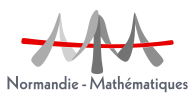Complétion de séries temporelles multi-variées en grande dimension
Soit le modèle de complétion :
$Y_i =\langle U_i,M_{k,\tau}\rangle +\langle U_i,\epsilon\rangle +\xi_i$,
Soit le modèle de complétion :
$Y_i =\langle U_i,M_{k,\tau}\rangle +\langle U_i,\epsilon\rangle +\xi_i$,
Théorème central limite pour des champs aléatoires sous la condition de Gordin
Dans cet exposé, on s’intéressera à des conditions projectives assurant la validité du théorème central limite dans le cadre de champs aléatoires stationnaires. On verra en particulier que la condition $L^1$ de Gordin, suffisante dans le cas des suites aléatoires, ne l’est plus dans le cadre des champs, et qu’une condition supplémentaire est alors nécessaire. Une application aux processus super-linéaires sera également envisagée.
Zero-inflated models have become a popular tool for assessing relationships between explanatory variables and a zero-inflated count outcome. In these models, regression coefficients have latent class interpretations, where latent classes correspond to a susceptible subpopulation with observations generated from a count distribution and a non-susceptible subpopulation that provides only zeros. However, it is often of interest to evaluate covariates effects in the overall mixture population, that is, on the marginal mean of the zero-inflated count.
Clavier Latex
Samuel nous présente son clavier Latex.
Abstract: In this talk I will introduce some nonparametric statistical learning techniques for sequential data in the presence of long-range dependencies. The relevant literature on this topic typically involves such parametric structural assumptions as autoregressive, moving average or Markovian models. However, the theoretical guarantees obtained under such standard modelling assumptions do not hold in the presence of statistical dependencies.
JOURNEE INTERNE DU LMRS (ANNULEE, REPORTEE EN 2022)
La journée interne du laboratoire aura lieu le 16/12 à 10h30 dans la salle de séminaire, suivant le programme :
Exposés de 20 minutes + 10 minutes de questions (Un grand merci aux trois volontaires !)
10h30-11h00 Vlad Barbu
11h00-11h30 Mohamed El Machkouri
11h30-12h00 Philippe Jouan
> 12h00 Pot organisé par le labo (désolé, le potluck n'est toujours pas possible).
Du phloème au paysage : quelques problèmes de modélisation continue des interactions plantes-ravageurs (reporté en février 2022)
Nous aurons le plaisir d'accueillir Y. Mammeri d'Amiens
Modèle de croissance d’interfaces aléatoires : limites hydrodynamiques et fluctuations
Dans cet exposé, nous présenterons quelques modèles d’interfaces aléatoires évoluant, à l’échelle microscopique, selon une dynamique Markovienne souvent en bijection avec des dynamiques de particules ou des modèles de dimères. Un des objectifs est de démontrer la limite hydrodynamique, c’est à dire la convergence de l’interface rééchelonnée en temps et en espace vers une interface macroscopique déterministe dont le mouvement est régi par une équation de Hamilton-Jacobi.
 Le LMRS est l'une des composantes
Le LMRS est l'une des composantes
de la Fédération Normandie-Mathématiques.
© 2026, Laboratoire de Mathématiques Raphaël Salem
